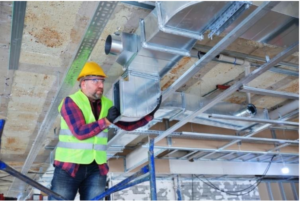Everything About Ventilation System
Ventilation systems are the unsung heroes of comfortable and safe indoor environments, tirelessly working behind the scenes to ensure we breathe clean air. Whether it’s in our homes, offices, or commercial spaces, these systems play a pivotal role in maintaining the quality of air we inhale by removing pollutants and controlling humidity. From natural breezes flowing through open windows to sophisticated mechanical systems filtering and circulating air, the world of ventilation is vast and varied.
In this article, we’ll dive into the intricacies of ventilation systems, exploring their importance, types, components, and how to choose and maintain the right system for your needs. Join us as we uncover the essentials of creating healthier indoor spaces and innovative solutions designed to enhance air quality and promote a sustainable future.
What is a Ventilation System?

A ventilation system is an essential component of modern buildings, designed to circulate fresh air while expelling stale, contaminated air from indoor spaces. Its primary goal is to maintain indoor air quality and provide a comfortable living or working environment. This system operates through a network of ducts, fans, and filters that work together to regulate airflow, temperature, and humidity levels.
Essential for ensuring the health and safety of occupants, ventilation systems remove pollutants, control moisture, and minimize odors, thereby preventing the buildup of harmful substances such as mold and bacteria. By balancing the intake of fresh air and the expulsion of exhaust air, these systems play a crucial role in energy efficiency, helping to reduce the need for heating and cooling, which in turn lowers energy costs. Understanding the importance and functionality of ventilation systems is key to appreciating their role in modern architectural design and building management.
Why is Ventilation Important
Ventilation is crucial because it ensures the removal of indoor air pollutants which can come from various sources like cooking, cleaning products, and outdoor pollution seeping indoors. It also controls indoor humidity levels, preventing the discomfort and health risks associated with too much moisture or dryness in the air. Importantly, ventilation prevents mold and mildew growth by removing excess moisture, a key factor in maintaining a healthy indoor environment.
Furthermore, it ensures an adequate oxygen supply by replacing stale indoor air with fresh outdoor air, vital for our well-being and cognitive function. In essence, good ventilation supports a healthier, more comfortable living and working environment, making it a key factor in residential and commercial building design.
Removes Indoor Air Pollutants
Ventilation systems play a vital role in removing harmful pollutants from indoor air. These pollutants can include chemicals from cleaning products, cooking fumes, and even outdoor pollutants that find their way inside. By circulating fresh air, ventilation helps keep the indoor environment safe and clean.
Controls Indoor Humidity Levels
Maintaining the right humidity levels is crucial for comfort and health. Ventilation helps balance moisture in the air, preventing it from becoming too dry or too humid. This balance helps avoid problems like dry skin or the growth of harmful organisms.
Prevents Mold and Mildew Growth
Excess moisture is a leading cause of mold and mildew in homes and buildings. By removing this moisture, ventilation systems prevent mold and mildew from growing. This is important for maintaining a healthy indoor environment and preventing damage to the building.
Ensures Adequate Oxygen Supply
Fresh air is essential for life. Ventilation ensures that indoor spaces have a continuous supply of oxygen while removing carbon dioxide and other exhaust gases. This keeps the air fresh and supports good health and well-being.
Types of Ventilation Systems

Ventilation systems can be categorized based on their method of circulating air within a building. Natural ventilation relies on passive airflow through windows, doors, and vents, harnessing wind and thermal buoyancy to refresh indoor air. Examples include operable windows and ventilation shafts, promoting air exchange without mechanical aid.
On the other hand, mechanical ventilation uses fans and duct systems to control air movement, with exhaust systems pulling stale air out, supply systems pushing fresh air in, and balanced systems doing both simultaneously. Hybrid ventilation combines natural and mechanical methods, optimizing energy efficiency and air quality. Each type serves different needs, from simple residential applications to complex commercial buildings, ensuring spaces are healthy, comfortable, and safe.
Natural Ventilation
Utilizes the natural forces of wind and thermal buoyancy to move fresh air through buildings, offering an energy-efficient way to maintain air quality without relying on mechanical systems.
Operable Windows
Enable occupants to manually control the airflow in space, providing a straightforward and effective means to introduce fresh air and enhance natural ventilation.
Ventilation Shafts
Designed to facilitate the upward movement of air, these architectural elements enhance natural ventilation by exploiting the temperature differences between indoor and outdoor environments.
Mechanical Ventilation
Employs fans and ductwork to actively manage the flow of air into and out of a building, ensuring consistent air quality and comfort levels are maintained.
Exhaust Systems
Targeted systems designed to extract stale air, pollutants, and excess moisture from indoor spaces, commonly utilized in kitchens, bathrooms, and industrial areas.
Supply Systems
Introduce fresh, filtered air into a building, offering a significant benefit in tightly sealed environments where natural ventilation is insufficient.
Balanced Systems
Incorporate both supply and exhaust functionalities to preserve optimal indoor air quality, guaranteeing that the volume of fresh air introduced matches the amount of stale air expelled.
Hybrid Ventilation
Merges natural and mechanical ventilation strategies, automatically adjusting between systems based on current conditions to achieve the best balance of energy efficiency and indoor air quality.
Components of a Mechanical Ventilation System

The efficiency and effectiveness of a mechanical ventilation system hinge on its core components, each playing a pivotal role in maintaining indoor air quality. Ducts, available in materials like metal, fiberglass, or flexible options, form the system’s backbone, channeling air throughout the building. Fans, which can be axial, centrifugal, or mixed flow, propel this air, ensuring consistent circulation.
Filters, including HEPA, carbon, and electrostatic types, cleanse the air of pollutants and particulates. Lastly, Air Handling Units (AHUs) integrate these elements, with functions to filter, heat, cool, humidify, or dehumidify the air as required. Together, these components work in concert to create a controlled, comfortable indoor environment, showcasing the complex interplay of technology and design in modern ventilation systems.
Ducts
Ducts are the essential pathways through which air is directed within a ventilation system. They are crafted from a variety of material types such as metal, fiberglass, and flexible options, each selected based on specific airflow needs and installation requirements.
Fans
Fans serve as the driving force in moving air throughout the system. They come in different types to suit various applications: axial fans for direct airflow paths, centrifugal fans for increased air pressure in challenging environments, and mixed flow fans that combine the qualities of axial and centrifugal fans for efficient air movement.
Filters
Filters play a critical role in purifying the air by trapping pollutants and particulates. Key types include HEPA filters, highly effective at capturing fine particles; Carbon filters, best for adsorbing odors and gases; and Electrostatic filters, which use an electrical charge to attract and hold particles.
Air Handling Units (AHUs)
AHUs are the heart of a ventilation system, integrating multiple functions to condition and circulate air. These units are responsible for filtering the air to remove impurities, heating and cooling the air to maintain desired indoor temperatures and humidifying or dehumidifying the air to ensure optimal humidity levels for comfort and health.
How to Choose the Right Ventilation System

Selecting the appropriate ventilation system requires a careful evaluation of the building’s specific needs. Start by assessing the size, layout, and occupancy of the space to determine the volume of air that needs to be circulated. Energy efficiency is another critical factor; look for systems with Energy Star ratings and those made from eco-friendly materials to ensure sustainable operation.
Additionally, consider the initial installation costs against the long-term savings in energy bills to make a cost-effective decision. By balancing these considerations, you can choose a ventilation system that not only enhances indoor air quality but also aligns with environmental goals and budget constraints.
Assess the Building’s Needs
First, evaluate the size, layout, and occupancy of the building. These aspects are foundational in determining the necessary capacity and type of ventilation system to ensure optimal air circulation and maintain high indoor air quality.
Consider Energy Efficiency
Prioritize systems with Energy Star ratings and those made from eco-friendly materials. Such choices not only support environmental sustainability but also guarantee that the system operates with high efficiency, leading to reduced energy consumption and lower operational costs.
Evaluate Cost
It’s important to weigh the initial installation costs against the long-term savings. While energy-efficient systems might come with a higher upfront price, they can offer substantial savings on energy bills over their lifespan, proving to be a cost-effective investment in the long run.
Maintenance of Ventilation Systems

Regular maintenance is key to ensuring that ventilation systems operate efficiently and effectively over time. This involves regular cleaning of components such as ducts, fans, and filters to prevent the accumulation of dust and debris, which can impair system performance and air quality. Filter replacement is also crucial; the frequency depends on the type of filter and the system’s usage but is essential for maintaining clean airflow.
Additionally, system inspections by professionals should be conducted annually to identify and address any potential issues before they lead to significant problems. Proper maintenance not only extends the lifespan of the ventilation system but also ensures it continues to provide a healthy, comfortable indoor environment.
Regular Cleaning
Regular cleaning of key components such as ducts, fans, and filters is essential. This routine maintenance helps to prevent the accumulation of dust and debris, ensuring the system operates efficiently and maintains high air quality.
Filter Replacement
The frequency of filter replacement varies and is dependent on the type of filter used. Regular replacement of filters is crucial for sustaining clean airflow and preventing pollutants from circulating within the indoor environment.
System Inspection
Annual professional checks are recommended to assess the health and functionality of the ventilation system. These inspections are vital for identifying and rectifying any potential issues early, thereby prolonging the system’s lifespan and performance.
Improve Ventilation Systems with Callidus Air
Callidus Air specializes in enhancing indoor air quality through advanced ventilation solutions tailored to meet the unique needs of both residential and commercial spaces. By leveraging state-of-the-art technology and eco-friendly practices, Callidus Air ensures that each ventilation system not only meets but exceeds energy efficiency standards, resulting in significant energy savings and reduced environmental impact. With a focus on customer satisfaction, Callidus Air offers comprehensive HVAC services including system design, installation, maintenance, and upgrades.
Whether it’s improving existing setups or installing new systems, Callidus Air is dedicated to providing solutions that optimize air quality, comfort, and overall building health, making it the go-to expert for all ventilation needs.
Final Thoughts
The significance of a well-designed and properly maintained ventilation system cannot be overstated. It is the cornerstone of ensuring a healthy, comfortable, and energy-efficient indoor environment. Whether through natural, mechanical, or hybrid systems, the goal remains the same: to provide clean air, control humidity, and maintain optimal living and working conditions.
By choosing the right system, prioritizing energy efficiency, and committing to regular maintenance, individuals and businesses can significantly improve air quality and contribute to a sustainable future. Callidus Air stands ready to assist with expertise and innovative solutions, reinforcing the importance of ventilation in our daily lives and the well-being of our planet.

